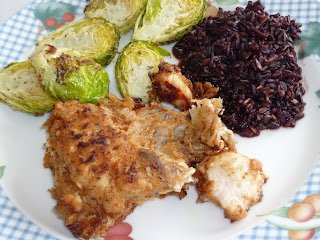I had some pork shoulder left over from the
Pork Pie and decided to make tamales for Cinco de Mayo. Since there wasn't enough left for a full batch of marinated-pork-only, I decided to bulk up the filling with some veggies and cheese. Sticking to the Mexican theme, I chose nopales, tomatillos, and a queso fresco. It mixes up the textures for an unusual blend.
Most of the effort and ingredients seem to be in the filling. The simmered pork is effort because you're also making the broth that will flavor the masa. The veggies have to be chopped, then sautéed and mixed with the shredded pork. Then you have to chop the cheese without getting it everywhere. Once you finally get all that made, assembling the tamales is almost routine.
Yes, this is a giant list of ingredients. Sorry.
*1/2 lb pork shoulder
3 C water
1/2 C onion, chopped
*1 rib celery, chopped
*1 clove garlic, minced
*1 tsp chili powder
1/2 tsp salt
*1/2 tsp ground cumin
*1/2 tsp whole coriander seed

1/2 lb tomatillos, husks removed, chopped
1 nopales paddle, needles removed, diced
1 Tb olive oil
1/4 tsp salt
1 Tb lime juice
12 oz queso fresco, cut into 18 wedges
22 corn husks, softened in warm water
2 C masa flour
1 tsp baking powder
1/2 C butter
2 C pork broth (made while cooking pork)
1. Into a medium saucepan, place pork, water, onion, celery, garlic, chili powder, 1/2 tsp salt, cumin, and coriander seeds. Bring to a boil. Reduce heat to a simmer and cook for about 2 hours, until pork is very tender. Strain off cooking liquid and reserve to use as broth for the masa. Shred pork and set aside. If you cooked it right, the meat will fall apart with very little effort.
2. To prepare filling, drizzle oil in a skillet and heat on medium. Lightly cook chopped tomatillos until they are soft and have given off most of their liquid, about 5 minutes. Add cactus with 1/4 tsp salt and cook until they start to soften, but are not limp, another minute. Remove from heat and add lime juice. Toss in shredded pork.
3. In a mixer with the paddle, beat butter until creamy. In a separate bowl, stir together baking powder and masa. Into flour, stir 2 C broth and make a thick batter. Add to butter and beat into a fluffy paste, about 2 minutes. If too dry, add more broth a tablespoon at a time.
4. To assemble tamales, arrange everything on the counter: softened husks, masa batter, pork & veggie mix, and queso slices. Place a kitchen towel on the counter as an assembly surface. On the stove, set up a steamer. I use a stock pot with a colander that happens to fit it perfectly. If you have a steamer basket, great. Start simmering two inches of water at the bottom of your steamer while you put everything together.
5. Lay one corn husk on your towel, pointy end down. On top half, spread about 3 Tb of masa batter. Onto that, spoon 1 Tb filling and place one piece of cheese. Bring in sides of corn husk and fold up pointy end. Take one of the husks that looks a little torn and tear off 1/2" strips to use as ties. Tie tamale and place, open end up, in steamer basket. Repeat until out of masa and fillings.
6. Place steamer basket over hot water, cover tightly, and cook for 90 minutes. Masa will expand slightly as it cooks. Check water level every half hour or so.
7. Serve hot with salsa, sour cream, or your choice of accompaniments.
Makes about 18 tamales, 6-9 servings
Difficulty rating $@%!





















